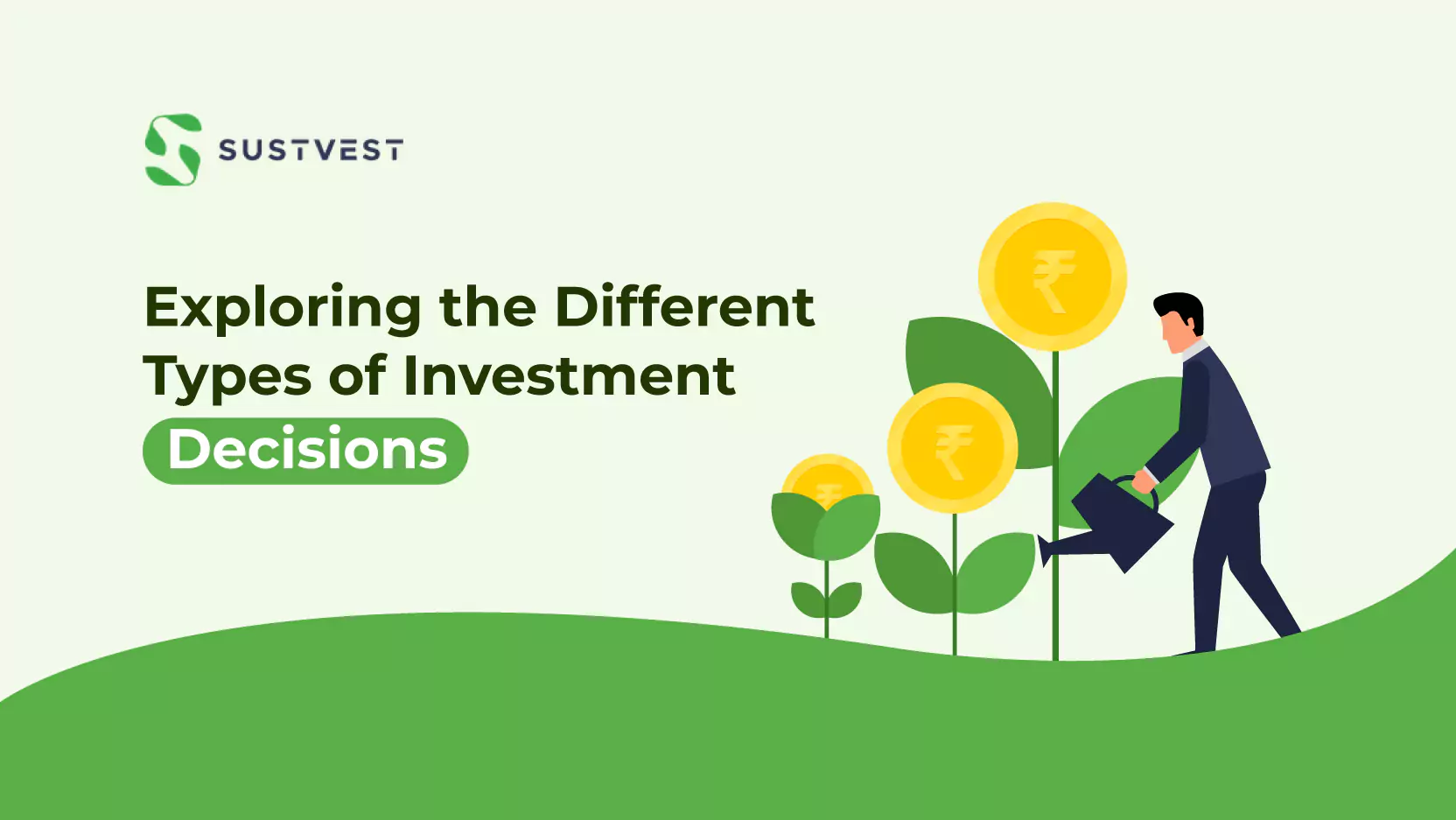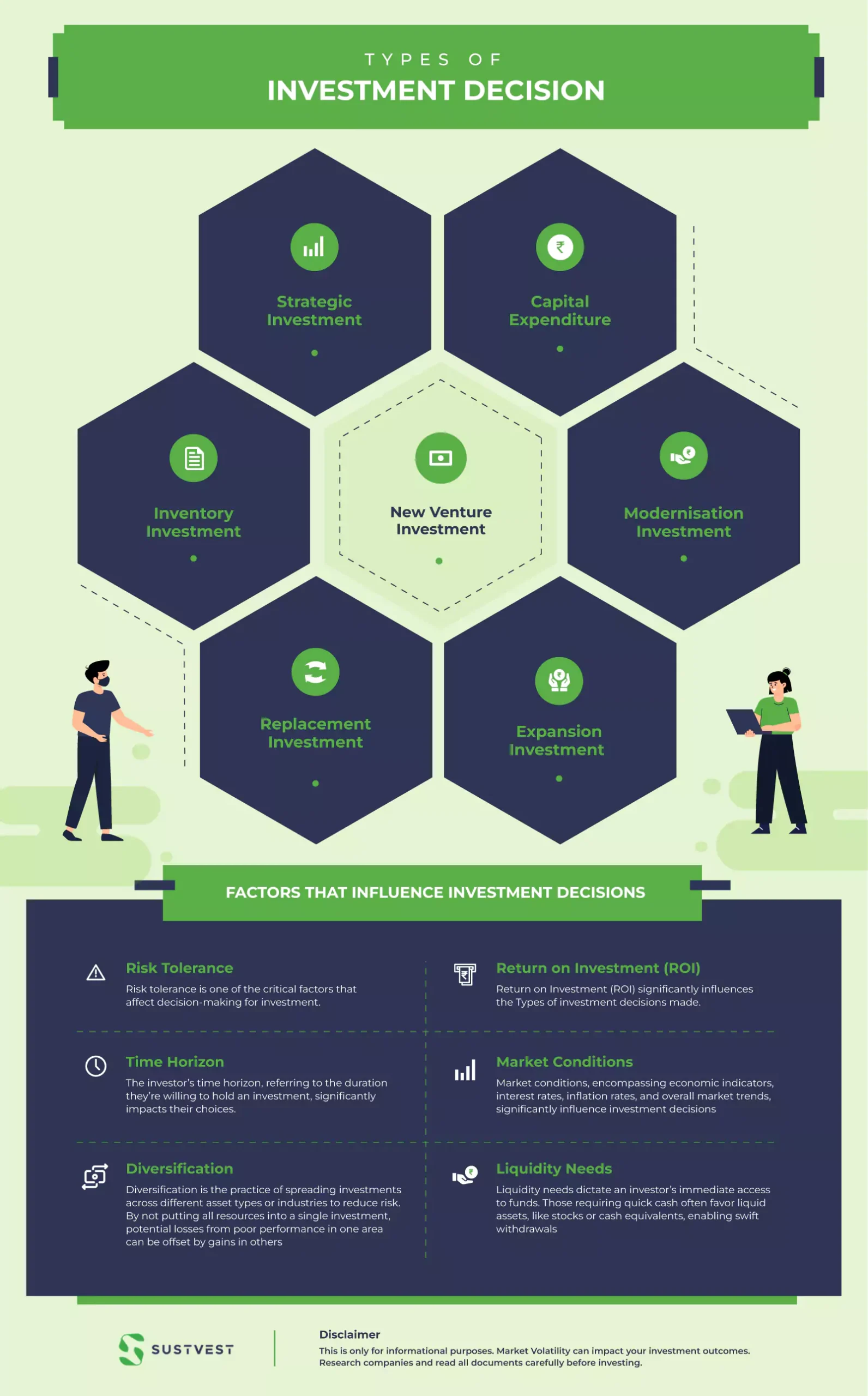Stepping into the Investing arena? It’s not just about rupees and paisa; it’s about decisions! The Types of investment decision you make can significantly shape your financial journey.
Imagine standing in front of a vast, intricate maze, each turn representing a different investment path.
Some paths might lead to growth, while others might be more about stability. Now, what if you had a guide to help navigate this maze?
Let’s embark on this adventure together, breaking down those intimidating walls and unveiling the secrets to making sound decisions.
Ready to decode the maze of investment choices? Let’s dive in!

What is an Investment Decision?
The investment decision process is a pivotal choice within a company. It involves the allocation of resources to yield optimal returns for investors. These decisions encompass both long-term and short-term strategies.
Financial Management is crucial for fund flow control. It addresses fund acquisition and utilisation in both long and short-term assets.
This domain navigates fund sourcing and expenditure, encompassing three vital choices: Investment, Finance, and Dividends.
Through adept Investment Decision-making, firms strive for growth, complemented by strategic Financial Decision-making to ensure efficient fund handling.
Concurrently, Dividend Decision-making balances returns for stakeholders. In essence, Financial Management orchestrates these decisions harmoniously to fortify a company’s fiscal health and prospects.
Types of Investment Decision
Investment decisions are crucial as they determine how resources are utilised to generate returns over time. Investment decisions are based on several criteria and goals.
Other than short-term and long-term decisions, other main types are:
- Strategic investment
- Capital expenditure
- Inventory investment
- Modernisation investment
- Replacement investment
- Expansion investment
- New venture investment
1. Strategic Investment
Strategic investment decision making entails identifying, evaluating, and selecting impactful projects that shape a company’s competitive edge, defining its products, operational scope, and processes.
A well-executed decision yields strategic and operational gains, while a misstep results in lost opportunities or wasted resources.
The significance of getting a strategic investment decision right cannot be overstated—success offers major advantages, and failure entails opportunity loss or resource waste.
2. Capital Expenditure
Capital expenditure decisions involve selecting long-term investments in non-saleable fixed assets like land, buildings, and machinery. This process encompasses planning, funding, and utilisation of resources.
The finance manager’s primary role is to choose the most profitable projects, a critical responsibility with lasting impacts on a firm’s performance.
This decision significantly influences the company’s operations and profitability over an extended period.
3. Inventory Investment
Inventory investment decisions involve determining the optimal levels of goods or materials a company should hold in stock to meet customer demand efficiently.
Striking the right balance ensures that sufficient inventory is available to prevent stockouts while minimising carrying costs.
Accurate forecasting, demand patterns, lead times, and supply chain considerations guide these decisions, directly impacting operational costs and customer satisfaction.
4. Modernisation Investment
Modernisation investment decisions involve allocating resources to update or upgrade existing processes, technologies, or systems within a company.
This strategic choice aims to enhance efficiency, competitiveness, and operational effectiveness. By embracing modernisation, companies can optimise their operations, reduce costs, improve customer satisfaction, and remain aligned with industry trends.
The decision to modernise demands careful evaluation to ensure the chosen upgrades align with the company’s long-term goals and provide a competitive edge in the ever-evolving business landscape.
5. Replacement Investment
A replacement investment decision involves evaluating and deciding whether to replace existing assets, equipment, or facilities with newer ones.
This decision hinges on factors such as:
- Deteriorating performance
- Technological advancements
- Efficiency gains
- Maintenance costs
It aims to maintain or enhance operational effectiveness, minimise downtime, and optimise resource allocation.
Making sound replacement investment decisions ensures continued productivity and cost-effectiveness while avoiding operational disruptions or inefficiencies caused by outdated or failing assets.
6. Expansion Investment
Expansion investment decisions involve allocating resources to grow a business’s operations, reach, or capacity.
Such decisions encompass various strategies, like entering new markets, expanding product lines, opening additional locations, or increasing production capabilities.
They require careful assessment of market demand, competitive landscape, potential risks, and financial feasibility.
Successful expansion investments can lead to increased market share, revenue, and brand recognition. However, inadequate analysis or execution can result in overextension, financial strain, or inefficiencies.
Companies must strike a balance between ambition and prudent planning, ensuring that expansion aligns with their core goals and resources.
Making expansion investment decisions demands a clear understanding of market dynamics, operational requirements, and risk management to secure sustained growth.
7. New Venture Investment
A new venture investment decision involves assessing the viability of funding and supporting nascent business initiatives.
This process demands careful evaluation of the venture’s market potential, competitive landscape, product or service innovation, management team capabilities, and growth prospects.
Investors weigh the potential returns against inherent risks, considering factors such as market trends, scalability, and the venture’s alignment with their portfolio objectives.
Successful new venture investment decisions can lead to significant financial gains and market expansion.
Conversely, misguided choices may result in capital loss and missed growth opportunities.
Thus, meticulous due diligence, market analysis, and alignment with strategic goals are essential to navigate the intricate landscape of new venture investments effectively.
Factors That Influence Investment Decisions
Investment decisions are influenced by many factors. Factors that influence investment decisions can be based on individual preferences, economic conditions, market trends, and organizational objectives.
Here are some common key factors that influence investment decisions:
1. Risk Tolerance
Risk tolerance is one of the critical factors that affect decision-making for investment. It refers to an individual’s comfort level with the uncertainty of potential losses.
Factors that influence decision-making, such as one’s financial situation, goals, and psychological disposition, determine their risk tolerance.
Those with a higher risk tolerance may choose investments with greater potential returns but also higher volatility, while risk-averse individuals prioritise safer options to minimise potential losses.
2. Return on Investment (ROI)
Return on Investment (ROI) significantly influences the Types of investment decisions made.
Investors gauge the promise of gains against the associated risks, opting for ventures that offer appealing potential returns in proportion to the level of risk involved.
This evaluation is a fundamental determinant guiding the selection of various investment avenues.
While ROI is a critical metric, it’s essential to understand the difference between Return On Investment vs. Return On Assets (ROI vs. ROA) to get a holistic view of an investment’s profitability.
3. Time Horizon
The investor’s time horizon, referring to the duration they’re willing to hold an investment, significantly impacts their choices.
A longer time horizon allows for aggressive growth strategies, while a shorter horizon necessitates more conservative selections.
Investors with extended horizons can endure short-term market fluctuations and aim for higher returns through growth investments.
Conversely, those with shorter horizons prioritise capital preservation and may opt for stable assets that align with their immediate financial needs.
4. Market Conditions
Market conditions, encompassing economic indicators, interest rates, inflation rates, and overall market trends, significantly influence investment decisions.
Positive economic outlooks, lower interest rates, and manageable inflation often encourage risk-taking and investment in growth assets.
Conversely, economic downturns and higher interest rates can lead to cautious approaches and a preference for more stable assets.
Investors analyse these conditions to align their choices with the prevailing economic climate, aiming to optimise returns while managing risks based on the expected market trajectory.
5. Diversification
Diversification is the practice of spreading investments across different asset types or industries to reduce risk. By not putting all resources into a single investment, potential losses from poor performance in one area can be offset by gains in others.
This strategy aims to create a balanced portfolio that can better weather market fluctuations.
Diversification lowers the impact of a single investment’s volatility on the overall portfolio, enhancing the likelihood of steady, long-term returns.
While diversifying, one must also weigh the pros and cons of Long term or short term investment – which is best for you? to decide the ideal tenure for each investment.
6. Liquidity Needs
Liquidity needs dictate an investor’s immediate access to funds. Those requiring quick cash often favor liquid assets, like stocks or cash equivalents, enabling swift withdrawals.
Conversely, investors with longer-term goals may choose less liquid assets, such as real estate, which require more time to sell.
Balancing liquidity needs is vital—too much liquidity may hinder potential returns, while too little might hinder timely financial obligations.
The investor’s financial timeline and ability to withstand fluctuations in asset value play a pivotal role in determining the right balance between liquidity and investment growth.

FAQs On Types Of Investment Decision
How does risk assessment impact investment decisions?
Risk assessment helps investors weigh potential gains against possible losses, guiding them in making informed investment choices.
What’s the significance of timing in investment decisions?
Timing matters as different investment horizons, such as short-term or long-term, influence the choice of assets and expected returns.
Why is diversification important in investment decisions?
Diversification spreads risk by investing in various assets, reducing the impact of a poor-performing investment on the overall portfolio.
Conclusion
Understanding the different types of investment decision provides a comprehensive understanding of how to allocate resources wisely.
Whether it’s assessing risk, evaluating returns, or considering time horizons, each decision type plays a vital role in achieving financial goals.
To embark on your journey towards informed investment choices, remember to analyze your options thoroughly and align them with your objectives.
To ensure a brighter and more sustainable future, one might also consider Investing in Green Energy for Environmental Conservation as part of their diversified portfolio.
For those interested in sustainable investments, explore the opportunities offered by SustVest to make impactful choices for both your portfolio and the planet.

Founder of Sustvest
Hardik completed his B.Tech from BITS Pilani. Keeping the current global scenario, the growth of renewable energy in mind, and people looking for investment opportunities in mind he founded SustVest ( formerly, Solar Grid X ) in 2018. This venture led him to achieve the ‘Emerging Fintech Talent of the Year in MENA region ‘ in October 2019.




